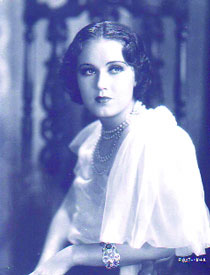The “King Kong” actress brought eroticism and comedy to early Hollywood classics
In real life, Fay Wray was ever so much more than the girl in King Kong’s paw atop the Empire State Building, an image that dogged her throughout her career.
She accepted the popular image with equanimity, even titling her autobiography “On the Other Hand,” self-deprecation perhaps, from one of the silver screen’s great beauties, particularly in the mid-1930s; she was peerless in her Fortuny or Mme. Gres haute couture, lacquered to perfection for studio photographers. Born sloe-eyed, with heavy-lidded bedroom eyes that slanted toward the East, she also had a succulent pout and a voluptuous body, the type once referred to as flesh impact.
These were the attributes that brought such an erotic charge to iconic films like “King Kong,” as well as to some of her other thrillers made between 1932-33: “Dr. X” and “The Mystery of the Wax Museum” (both in early Technicolor), “The Vampire Bat” and the fascinating “The Most Dangerous Game.” Her full-lunged screams, gasps and moans came across far more eloquently than the flat scripts she was handed.
Due to the nearly unquenchable thirst for gory thrills, these films are how she is remembered, to the detriment of far more superior performances she achieved. Wray made her film debut at age 16 in 1923 and became a star when ravishingly filmed by Erich von Stroheim in “The Wedding March” (1928), her personal favorite. She also worked with other eminent European directors, like Mauritz Stiller, who discovered Greta Garbo, in “Street of Sin” (1928), and Josef von Sternberg, Marlene Dietrich’s discoverer, in his first talkie, “Thunderbolt” (1929).
She was a delightful comedienne, as she proved in Gregory La Cava’s witty “The Affairs of Cellini” (1934), where she played a slow-witted Italian model’s artist. She glorified Belle Epoque style as a seductresses in “One Sunday Afternoon” and in “The Bowery,” probably her sexiest role. She made a striking appearance in MGM’s troubled “Viva Villa,” sadistically whipped at one point by a manic Wallace Beery. She was terrific opposite Claude Rains as a false psychic, in the gripping British film, “The Clairvoyant” (1934).
Her first husband, World War I veteran and writer John Monk Saunders, penned a Broadway musical for her, “Nikki,” inspired by Ernest Hemingway’s “The Sun Also Rises,” in which Wray appeared opposite an unknown actor, Archibald Leach, who was in love with her, and after taking the first name of his character, would forever be known as Cary Grant. Wray’s marriage to Saunders was a troubled one—at one point he kidnapped their daughter, Susan, and following their divorce he committed suicide in 1940.
Wray married twice more, to Frank Capra screenwriter Robert Riskin (with whom she had two more children, Victoria and Robert, Jr.), and then16 years after his 1955 death, to his physician, Dr. Sanford Rothenberg. She also had a devastating effect on Howard Hughes, and the writers Sinclair Lewis (who wrote a play, “Angela at 21,” with her) and Clifford Odets, who considered her the ideal woman.
I met Fay Wray at Sotheby’s, at a pre-auction viewing of Billy Wilder’s art collection.
“They’re not very good,” she said to me, a remark with which I heartily concurred. This was the perfect opening and I found myself asking her about a delightful film I’d just seen, “The Richest Girl in the World,” one of the best romantic comedies of the 1930s. Wray played the secretary/stand-in to a very Barbara Hutton-esque heiress (Miriam Hopkins) and she recalled the film with pleasure. She said she enjoyed working with the notoriously difficult Hopkins and remembered how awed she was that the star’s wardrobe was specially made by Hattie Carnegie and flown in from New York.
Wray’s last public appearance was at Sardi’s on June 7, for the premiere of the film “Broadway: The Golden Age.” Even in a room filled with the likes of Celeste Holm, Jane Powell, Farley Granger, Ben Gazzara, Tammy Grimes, Michele Lee, Tommy Tune and others, Wray, although quite frail, was the lovely standout. The director Peter Jackson, now preparing his remake of “King Kong,” was there and the photo op of the night was the two of them together, as he pitched his idea for Wray’s participation in the film.
Personally, I had always been intrigued by her friendship with the legendary star, Dolores del Rio. In the late 1930s and into the early ‘40s, the two seemed like darkly gorgeous complements of one another. Wray had been del Rio’s character witness at her divorce from MGM art director, Cedric Gibbons, and made cryptic references to her in her autobiography. She described del Rio’s obsession with her own beauty, how she made a cult of it and one final, touching meeting between them. I took the opportunity to ask Wray about her. At the mention of her name, Wray’s eyes sparkled and, very slowly, she replied, “Yes, she was beautiful. She moved to Mexico and I never saw her again.”
Last week, on August 10, in Fay Wray’s honor, the Empire State Building dimmed its lights for 15 minutes.


































